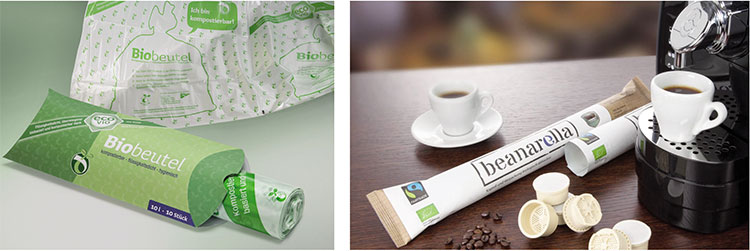Packaging and bioplastics – Data 2018
Overview on market and developmental trends.

Given the growing interest in bioplastics in the packaging sector, it is necessary first of all to clarify the nature of these materials.
First of all it must be pointed out that there is a substantial difference between bioplastics and biodegradable plastic which, thanks to the action of some microorganisms, degrades over time. According to the definition of the European Bioplastics Association, the term bioplastics refers to those plastics that derive at least in part from a biomass (biobased, or biologically based), or that are biodegradable or, again, that possess both characteristics. Ultimately a bioplastic may be biodegradable or not.
Production in Europe and Italy
In 2018, according to the European Bioplastics association, around 2.11 million tons of bioplastics were produced in the world, of which 60% was for packaging production (1.3 million tons).
Europe is in second place in the ranking of bioplastics producers, with a share of 20%, second to Asia which represents 50% of world production.
In its annual report, the European association of bioplastics producers points out that the sector will in the next five years feature a constant growth that will be around 20% in all.
The reasons behind this development are many: on the one hand the transition towards a type of circular economy and its support, on the other the constant growth of consumer interest in sustainable products and packaging.
In the packaging field, the uses of this material are manifold, even though, at present, shopper bags and pouches used for the segregated collection of organic waste that lead the sector.
According to the latest assessments available, in 2018 in Italy about 88,500 tons of bioplastics were produced against 73,000 tons in 2017, with a growth rate of + 21%. In first place, for the use of bioplastics, we find bags for carrying away goods with 61% of the total and an increase of 8.4% over 2017, followed by ultralight bags (bags used for packaging loose fruit and vegetables) accounting for 19%, while the remaining 20% is divided between bags for the collection of organic waste, agricultural items, catering (disposable tableware), food packaging (trays) and personal hygiene.
Bags spur on development
According to data from the Italian Packaging Institute, the production of plastic shopper bags, both traditional and biodegradable used for food shopping, reached 98,000 tons in 2018, of which it is estimated that about 55% pertain to bioplastics (around 54,000 tons).
From the analysis of these figures it is clear that, from 2017, there has been a decrease in the total of shopping bags (plastics + bioplastics) of 3% (in 2017 it was about 101,000), but at the same time those made with bioplastics have increased, ending up as being more than the half of the total plastic bags used on the Italian market.
After the entry into force of the law that banned the marketing of traditional plastic shopping bags in January 2011, but which only provided penalties for offenders since 2015, there was an exponential increase in the number of shopper bags made of bioplastics in Italy that have in fact gradually replaced traditional ones.
From January 2018 another Directive was introduced in Italy to bring the country in line with the rest of Europe. The obligation to use bioplastic bags for loose food or fruit and vegetables, butchery, fishmonger and delicatessen products, that is to say very light bags with a thickness below 15 micron, has been added to the obligations already in force since 2011.
If on the one hand, the law on bags has meant that traditional plastic was replaced by bioplastics, it has also led to a general decrease in the use of shopper bags, inducing consumers to use reusable bags, made out of cloth or plastic, with increasing frequency.
In percentage, bioplastics are also used in the production of bags for organic waste (14%), films (4%), other applications (2%), including preforms for bottles, trays and disposable tableware (other non packaging items are included in the “other application” listing).
Application of bioplastics in disposable items
The recent approval of the European directives aimed at banning disposable objects made of plastic, in particular with regard to tableware, is causing confusion in the market, considering also that Italy is in first place in Europe for consumption and production of these products.
According to Assobioplastiche there are excellent chances that compostable bioplastics can be excluded from the directive in question. In this way we could hypothesize a substantial increase in the consumption of compostable bioplastics for the production of disposable tableware, replacing traditional plastic.
If the Italian Parliament accepted this interpretation of the directive, and if this interpretation were accepted by Brussels, the production of disposable tableware should be converted to compostable bioplastics, safeguarding an important industrial area and hundreds of jobs.
Barbara Iascone
Istituto italiano Imballaggio




















